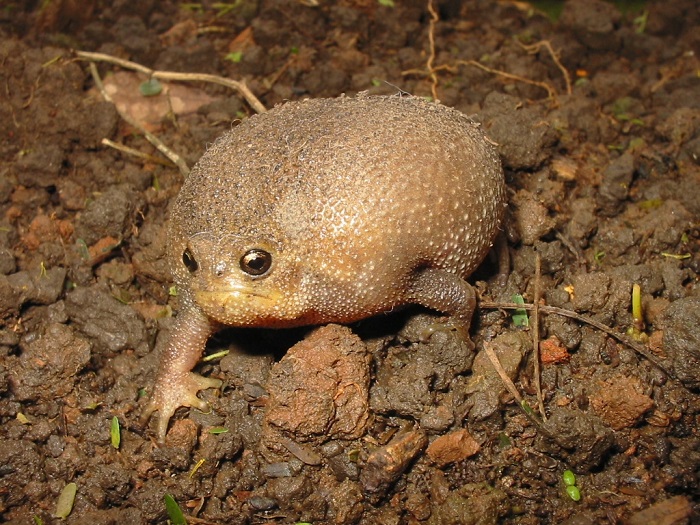Cover photo by Cornelia Rautenbach.
Find the Plaintive Rain Frog in the FBIS database (Freshwater Biodiversity Information System) here.
Family Brevicepitidae
Identification
The female Plaintive Rain Frog attains a length of 53mm (males are smaller than females). The body is stout with short legs and relatively small eyes. The colouration of the upper sides is variable but is most often tan-brown to dark brown with black markings. Specimens from forested places can be mostly black, sometimes with paler spots. Both the upper and lower parts are granular.
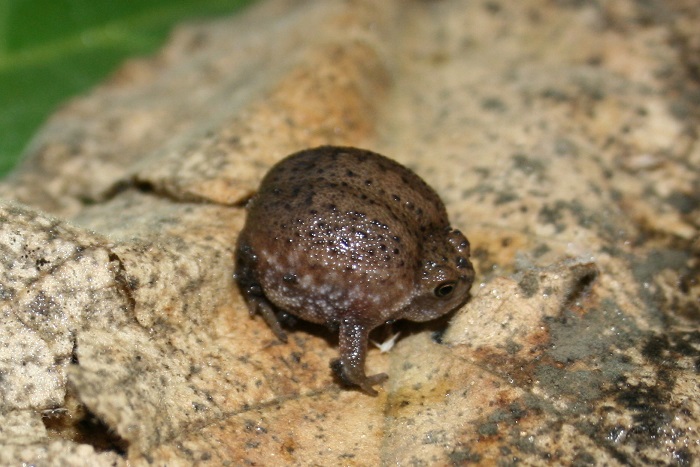
Hela-hela, KwaZulu-Natal
Photo by Cornelia Rautenbach
Habitat
The natural habitats of the Plaintive Rain Frog are indigenous forest and the adjacent grassland along the eastern escarpment. Along the great escarpment, the Plaintive Rain Frog occurs in Moist Upland Grassland, North-eastern Mountain Grassland, Afro Mountain Grassland, and adjacent Afromontane Forest. Along the Eastern Cape and KwaZulu-Natal coast, it inhabits Coastal Bushveld/Grassland, Coastal Forest, Sand Forest, and Dune Thicket. At Pennington in KwaZulu-Natal (3030BC), males were heard calling in dense, matted grass, five metres from the high-water mark (Minter 1998). Between the coast and the escarpment in KwaZulu-Natal, it is found in Short Mistbelt Grassland. At Eshowe, calling males were collected in suburban gardens (Minter 1998).
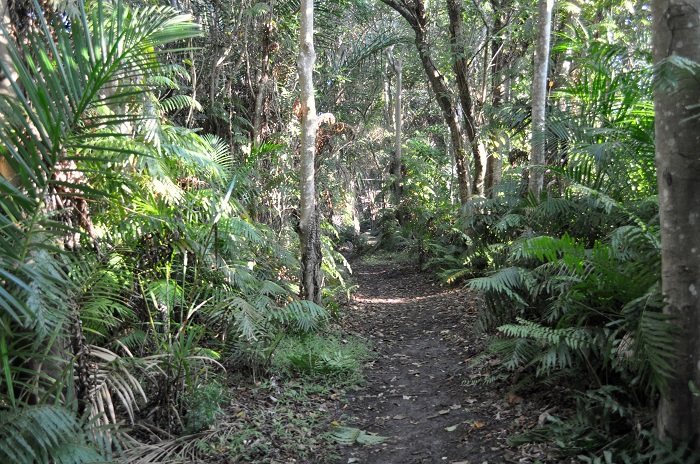
Mtunzini, KwaZulu-Natal
hoto by Ryan Tippett
Factors that are common to these vegetation types, and may limit the distribution of this species, are annual rainfall in excess of 700 mm and well-shaded soil, which result in higher soil moisture levels over relatively longer periods than is the case in drier, more open habitats.
Behaviour
During dry periods, the Plaintive Rain Frog remains below the surface. Minter (1998) followed a shallow burrow for 3 m until it dipped down and disappeared under a large rock, and found deep, vertical burrows near the call sites of several males. Specimens have also been collected under rocks (Jacobsen 1989).
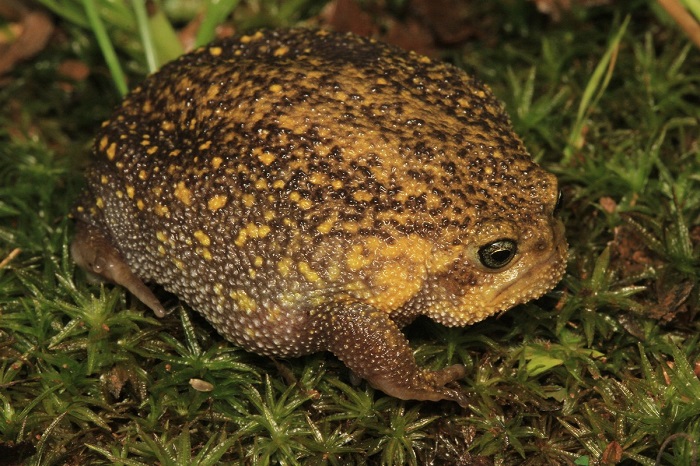
Baziya forest, Eastern Cape
Photo by Luke Kemp
The breeding period of the Plaintive Rain Frog is relatively short, commencing with the first spring rains in August or early September and seldom extending beyond mid-November. Choruses develop rapidly in rain, drizzle or heavy mist and continue unabated, day and night, as long as the wet weather lasts. Males are prompted to vocalize by the calls of their immediate neighbours, and in this way bouts of calling spread through the population in waves, as in the Bushveld Rain Frog B. adspersus. The Plaintive Rain Frog is easily prompted to call by a tape recording or human imitation of the call, even when no other calling is taking place (pers. obs.). Calling is inhibited by wind and low temperatures (Minter 1998).
The call site is usually a well-concealed, shallow depression under dense, matted grass or leaf litter, but males may call at the surface, or from elevated positions on grass tussocks, up to 40 cm from the ground (Poynton and Pritchard 1976; Minter 1998). Amplexus, oviposition and development have not been recorded.
Food items include amphipods, isopods, juvenile myriapods, caterpillars, beetles and ants (Poynton and Pritchard 1976).
Status and Conservation
The Plaintive Rain Frog is widely distributed in a variety of habitats and does not appear to be at risk. It occurs in a number of provincial nature reserves and in the Golden Gate Highlands National Park (Bates 1995).

Mariepskop, Limpopo
Photo by Luke Verburgt
Distribution
The Plaintive Rain Frog is endemic to South Africa, Lesotho, and eSwatini (Swaziland). It occurs along the Great Escarpment, from the Nico Malan Pass (3226DA) in Eastern Cape Province, northward through Lesotho, KwaZulu-Natal and Swaziland, to the Blyde River Canyon Nature Reserve (2430DB) in Mpumalanga. A single specimen was collected on the border of Lesotho, in eastern Free State (Bates 1995). The species descends into moist grassland and forest east of the escarpment, reaching the coast at Coffee Bay (3129CD), and extending along the coast as far north as Empangeni (2831DD). The most southerly record is based on a museum specimen from Zuurberg (3325BC).
The great variation in colour and markings present in different populations of this species is attributed to crypsis. For example, individuals living in forest and along the forest fringe at Graskop (2430DD) are black with fine, cream speckles, while those living on light sandy soils at Eshowe are uniformly light brown (Minter 1998). Populations from grassland habitats in Eastern Cape Province exhibit a varying degree of light brown mottling on a dark brown background, and were previously referred to a separate subspecies, B. v. tympanifer. However, similar marking are seen on specimens from grassland habitats in KwaZulu-Natal and Mpumalanga, while a population sampled at the grassland/forest interface at Wesa (3029DA) contains entirely melanistic as well as mottled individuals (Lambiris 1989a; Minter 1998). Therefore, B. v. tympanifer does not represent a valid subspecies, but rather a cryptic colour variation in grassland (Minter 1998). These various populations show no differences in advertisement-call structure, which confirms that they are conspecific (Minter 1998).
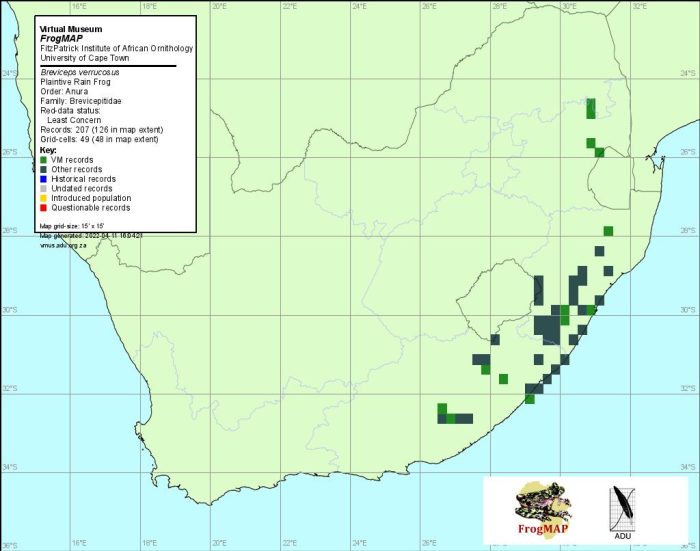
Breviceps maculatus, described from montane grassland in the KwaZulu-Natal Drakensberg (FitzSimons 1947), has been recognized by some authors as a distinct species (Poynton 1964; Lambiris 1989a, 1991) on the basis of dorsal markings and larynx structure, while others have placed maculatus in the synonymy of B. verrucosus because of the similarity of their advertisement calls (Passmore and Carruthers 1979, 1995; Bates 1995; A. Channing pers. comm.; pers. obs.). B. maculatus is not treated as a separate taxon in this atlas, but an analysis of a larger sample of specimens and calls is required in order to validate this viewpoint.
The atlas data are reliable, but incomplete. The taxonomic status and distribution of populations in Lesotho, and along the escarpment in Mpumalanga, and possibly Limpopo Province, warrant further investigation (see B. sylvestris species account).
Further Resources
The use of photographs by Cornelia Rautenbach, Luke Kemp, and Luke Verburgt is acknowledged.
Plaintive Rain Frog Breviceps verrucosus Rapp, 1842
Other Common Names: Klaende Reënpadda (Afrikaans)
Recommended citation format: Minter, LR; Tippett, RM. (2025). Plaintive Rain Frog Breviceps verrucosus. Biodiversity and Development Institute, Cape Town. Available online at https://thebdi.org/2021/12/15/plaintive-rain-frog-breviceps-verrucosus/
This species text has been updated and expanded from the text in the
2004 frog atlas: Minter, LR. (2004). Plaintive Rain Frog Breviceps verrucosus. In Minter LR et al 2004.
References:
Minter, LR; Burger, M; Harrison, JA; Braack, HH; Bishop, PJ; Kloepfer, D. (Editors). (2004). Atlas and Red Data Book of the Frogs of South Africa, Lesotho and Swaziland. Smithsonian Institution, Washington, and Avian Demography
Unit, Cape Town.
Carruthers, V; du Preez, L. (2017). Frogs of southern Africa: A Complete Guide. Struik Nature, Cape Town.
Channing, A. (2001) Amphibians of Central and Southern Africa. Protea Book House, Pretoria
Claus, B; Claus, R. (2002). Common Amphibians and Reptiles of Botswana. Gamsberg Macmillan, Windhoek.

